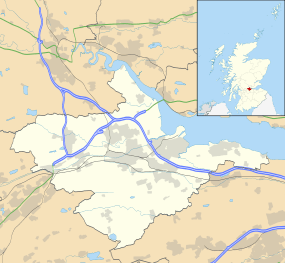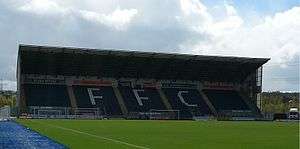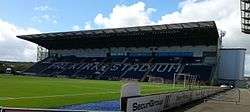Falkirk Stadium
| Westfield | |
|
The main west stand | |
 The Falkirk Stadium Location in Grangemouth | |
| Location |
Westfield Falkirk Scotland |
|---|---|
| Coordinates | 56°00′19.37″N 3°45′9.50″W / 56.0053806°N 3.7526389°W |
| Owner | Falkirk Community Stadium Ltd |
| Capacity | 7,937[1] |
| Record attendance |
7,851 v Hibernian 13th May 2016 |
| Field size | 105 x 68 m [2] |
| Surface | synthetic pitch |
| Construction | |
| Broke ground | 2003 |
| Opened | 2004 |
| Expanded |
2004–2005 (North stand) 2009 (South stand) |
| Architect | Falkirk Council |
| Main contractors |
Mowlem (North stand and West stand) Ogilvie (south stand) |
| Tenants | |
|
Falkirk FC (2004–present) | |
| Website | |
|
www | |
The Falkirk Stadium is a football stadium in the east of Falkirk in central Scotland, which is the home ground of Scottish Championship club, Falkirk. The stadium has a capacity of 7,937[1] and currently consists of three fully completed stands.
The stadium was opened in 2004 with the main stand completed. It became the home of Falkirk in the same year after the club ground shared Ochilview Park for the 2003–04 season whilst the stadium was being constructed. The north and south stands were built and opened in 2005 and 2009 respectively.
History
Work began on building the stadium in 2003[3] after Brockville Park, the club's town centre home since 1885, was sold and demolished.[4]
The project of building the stadium was a partnership between Falkirk Football Club and Falkirk Council who set up the Falkirk Community Stadium Ltd which provided the funds to construct and run the stadium.[5] Falkirk Council estimated £6.1 million would be required for the first stage of the Community Stadium build and would contribute £3.1 million initially. The sale of Brockville Park amounted to £9 million pounds for the club, of which £2.8 million went towards the build, whilst £200,000 came from sportscotland.
The first stage of the stadium was completed in time for the 2004–05 football season and Falkirk moved in after spending the previous year ground-sharing with local rivals, Stenhousemuir at their Ochilview Park home.

Falkirk's first ever game at the stadium was a friendly in July 2004 against Dundee resulting in a 2–1 defeat.[6] A month later the first league game was hosted in the stadium with visitors Hamilton Academical drawing 1–1.[7]
In October 2004 construction work commenced for the building of a second stand to the north of the pitch.[7] The stand has a capacity of 2,000. After completion, the £1.58m[8] facility would bring the stadium's capacity to over the Scottish Premier League's 6,000 seating criteria meaning Falkirk would be allowed automatic promotion[9] from the First Division. The stand received its safety certificate in late March 2005, shortly before the SPL's deadline for a stadium which met the seating criteria.[9] By May of the same year the north stand was fully completed.[10]
Construction of the south stand began in December 2008 by contractors Ogilvie.[11] A £2m pledge from Sandy Alexander, founder of Schuh and Falkirk supporter, helped fund the project.[11] The south stand has a capacity of around 2,000 and is identical in appearance to the north stand of the stadium.[12] It was officially opened in August 2009 in a friendly game against Royal Antwerp FC of Belgium.[13] This brought the capacity of the stadium to around 8,000 people without the inclusion of the temporary east stand.
The joint venture that was set up between Falkirk F.C. and Falkirk Council, ended in 2009, just a few months before the opening of the south stand. The football club took full control of the facilities such as the pitch, seats, under-soil heating and floodlights,[5] whilst the council retained most of the development rights for the site and manages and receives rent from businesses set up the stadium's main west stand.[5]
An artificial playing surface was installed at the stadium in June 2013.[14]
Structure and facilities

The Falkirk Stadium is an all-seater stadium which currently consists of three completed stands in the form of the main west stand and smaller north and south stands. Upon the stadium's construction the west stand was the first to be built, and subsequently completed in 2004. The north and south stands were completed in 2005 and 2009 respectively. The west stand has a capacity of roughly 4,200[15][16] and hosts several facilities which have ranged from a nursery to a restaurant. A temporary east stand has been present on several occasions.

Other uses
As well as hosting the home games of Falkirk in football, the stadium has also hosted several youth level international rugby matches.[17] In 2008 the stadium was the venue chosen by the Scottish Rugby Union to host Scotland's home matches at the Six Nations Under 20s Championship which were played against England under-20s and France under-20s.[18] Former Falkirk manager John Hughes had commented on the condition of the pitch which was previously damaged during rugby matches.[17]
The stadium is also used on occasion by the Scotland women's national football team in World and Euro qualifying championships as well as in friendly matches.[19] Also in relation to football, the stadium has hosted the home matches of the Scotland national under-21 football team, the first happening in November 2004 in a game against Sweden.[20]
The Falkirk Stadium hosts summer music concerts, marketed under the "Rock The Stadium" brand.[21] The first act to appear at the Falkirk Stadium was Elton John, on 10 June 2012 as part of his Greatest Hits Tour.[22] In subsequent years, Status Quo (23 June 2013),[23] Midge Ure (22 June 2013),[24] Rod Stewart (21 June 2014)[25] and Tom Jones (1 August 2015)[26] have performed.
Transport
The Falkirk Stadium is within a 30-minute walk of Falkirk Grahamston railway station which is on the main Edinburgh to Dunblane Line and Cumbernauld Line from Glasgow. During weekdays and Saturdays alternate trains between Glasgow and Cumbernauld call at Falkirk Grahamston.[27]
Special match day bus services provided by First Scotland East allow direct transport to the stadium from around the Falkirk area.[27] The number 98 service from Brightons passes through Shieldhill, Hallglen and Laurieston before terminating at the stadium. Access from Larbert on match days is provided by the number 99 bus, which is destined for the stadium via Stenhousemuir, Carronshore and Bainsford.[27][28] As well as the special match day routes, regular services are also provided by First Scotland East from Falkirk bus station to Grangemouth (routes 3 and 4/4A) and Linlithgow (routes 6A and 7) which stop outside the stadium.[27][29]
References
- 1 2 "Falkirk Football Club". Scottish Professional Football League. Retrieved 11 November 2013.
- ↑ Ground Guides, SFL. Retrieved 11 January 2012.
- ↑ Falkirk Stadium approved ... now work begins, Falkirk Herald. 20 March 2003. Retrieved 10 January 2012.
- ↑ £9 million deal agreed for Brockville, Falkirk Herald. 19 July 2002. Retrieved 10 January 2012.
- 1 2 3 "Football stadium venture to end". BBC News. BBC. 4 March 2009. Retrieved 10 January 2012.
- ↑ Grahame, Ewing (26 July 2004). "Bairn again but Dundee contrive to rain on the Falkirk stadium parade". Daily Mail. Retrieved 3 September 2013.
- 1 2 News, The Falkirk Stadium. 25 July 2004. Retrieved 11 January 2012.
- ↑ Work to start on new stand, Falkirk Herald. 29 April 2004. Retrieved 12 January 2012.
- 1 2 Falkirk stadium gets green light, BBC Sport. 31 March 2005. Retrieved 11 January 2012.
- ↑ Falkirk Stadium building design, Falkirk Council. Retrieved 11 June 2013.
- 1 2 Work on third stand gets underway, BBC News. 3 December 2008. Retrieved 12 January 2012.
- ↑ What's The Ground Like?, Scottish Football Grounds Guide. 22 April 2013. Retrieved 11 June 2013.
- ↑ Club debut for new stadium stand, BBC News. 30 July 2009. Retrieved 12 January 2012
- ↑ Oliver, David (13 June 2013). "Falkirk are pitching in to bring the Bairns back to town". Falkirk Herald. Retrieved 13 June 2013.
- ↑ Campbell, Alan (20 March 2005). "Falkirk keep rising from the rubble in more ways than one". The Sunday Herald. Retrieved 3 September 2013.
- ↑ New Home, New Standards, TalkFootball. Retrieved 11 January 2012.
- 1 2 Fisher, Stewart (17 February 2008). "Hughes appeals for an end to rugby at Falkirk Stadium". Sunday Herald. Retrieved 3 September 2013.
- ↑ U20's Six Nations Fixtures and Results, Retrieved 16 March 2012.
- ↑ "Scots women buoyed by addition of baby Fleeting to the squad". The Scotsman. Johnston Publishing. 31 March 2010. Retrieved 3 September 2013.
- ↑ "Pitch-perfect at Falkirk Stadium". Falkirk Herald. 18 November 2004. Retrieved 3 September 2013.
- ↑ https://twitter.com/RocktheStadium
- ↑ "Elton John to play Falkirk Stadium gig". BBC News. BBC. 1 December 2011. Retrieved 16 March 2012.
- ↑ http://www.dailyrecord.co.uk/entertainment/music/music-news/rockers-status-quo-thrilled-after-1494770
- ↑ http://www.falkirkherald.co.uk/news/local-news/1980s-pop-stars-set-to-rock-falkirk-1-2689319
- ↑ http://www.scotsman.com/what-s-on/music/gig-review-rod-stewart-falkirk-1-3452900
- ↑ https://www.facebook.com/rockthestadium
- 1 2 3 4 Falkirk FC - Parking and Travel, falkirkfc.co.uk. Retrieved 16 March 2012.
- ↑ South East and Central Scotland - Timetables for Service Number: 99, First Scotland East Retrieved 16 March 2012.
- ↑ South East and Central Scotland - Timetables, First Scotland East Retrieved 16 March 2012.
External links
| Wikimedia Commons has media related to Falkirk Stadium. |

